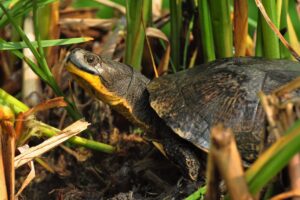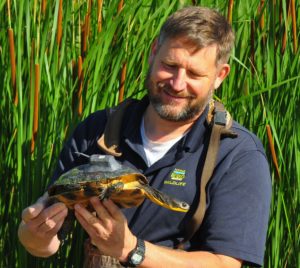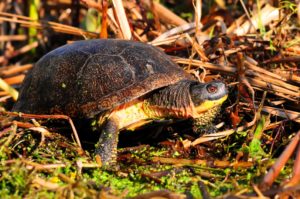Photography courtesy of Lowell Washburn, all rights reserved.
Following decades of silence, some of Iowa’s most secretive reptiles have begun emitting radio signals from the watery depths of Eagle Lake. Twelve hours on and twelve hours off, the daily transmissions are being closely monitored by a team of wildlife diversity experts with the Iowa DNR. The rapidly accumulating data is contributing to a first of its kind project aimed at enabling researchers to stall the ongoing decline of the iconic Blanding’s turtle, one of the state’s most interesting, but rarely observed, forms of native wildlife. Located in Hancock County, the 900-acre Eagle Lake Wildlife Area is one of a declining number of Iowa wetlands still harboring a viable population of this threatened species.

“Blanding’s turtles are extremely secretive,” says DNR Wildlife Research Technician, Dave Hoffman. “Since we can’t rely on visual sightings, the use of radio telemetry is our best way to gain knowledge of this declining species. Programed to operate in twelve-hour cycles, our transmitters have an estimated lifespan of nine years. We hope to learn a lot of things from this study – things like habitat use during spring and summer, habitat use during winter hibernation, or how migrating females select upland nesting sites. One of the most important questions is why there are virtually no young turtles being added to existing populations.”
DNR wildlifers are employing underwater baited cage traps to obtain samples of Eagle Lake’s most elusive species. But while the public wildlife area continues to support hundreds of painted and snapping turtles, Blanding’s turtles have become alarmingly scarce. In an area where the unique reptiles were once common, researchers have only succeeded in capturing three male and one female Blanding’s so far this summer. After being equipped with the long lived, glue-on transmitters, the turtles were released to begin sharing their secrets. During the past three years there have also been single sightings of Blanding’s turtles at Cerro Gordo County’s Zirbel Slough and Mallard Marsh. At least two Blanding’s have also been documented at the DNR’s Wild Goose Marsh Wildlife Area, located 4 miles north of Ventura.

One of the things researchers hope to learn at Eagle Lake is what type of habitats are most seasonally preferred by Blanding’s, says Hoffman. Radioed turtles are currently concentrating in a location known to area duck hunters as ‘The Burn Out’ — an area containing shallow crystal-clear water with an abundant combination of both emergent and submergent aquatic plant life.
“We’re also examining the overall importance of varying water depths,” says Hoffman. “We are especially interested in learning how wetland drawdowns – either through intentional management events or natural droughts – might impact turtle survival.”
Regardless of existing water levels, biologists note that the spring and summer breeding season is a dangerous time for all turtle species as pregnant females leave wetlands to search for upland nesting sites. For Blanding’s turtles, vehicle strikes represent the highest known cause of adult mortality.
When digital X-rays revealed that the Eagle Lake female was holding a clutch of nineteen eggs, the turtle was medically induced to lay her eggs. Those eggs are currently being incubated by Dr. Jeffrey Tamplin, a University of Northern Iowa professor who is also currently working with the endangered Iowa wood turtle.
A turtle’s gender is largely determined by the temperature of developing eggs. Moderate temperatures produce males while temps rising above 80 degrees result in female hatchlings. Utilizing temperature control, Tamplin has engineered the Eagle Lake eggs to produce an all-female hatch. Because of their higher incidence of [road] mortality, females are considered to be the most valuable components of Blanding’s populations. In extreme cases, the loss of a single female has the potential to doom the entire population of an isolated marshland.

Once the Eagle Lake eggs hatch, biologists hope to increase survival by raising hatchlings to a larger size before returning the adolescent turtles to their wetland home. A similar rearing program is helping to stabilize endangered Blanding’s populations in neighboring Illinois.

 Tom Cope
Tom Cope Sue Wilkinson
Sue Wilkinson Susan Judkins Josten
Susan Judkins Josten Rudi Roeslein
Rudi Roeslein Elyssa McFarland
Elyssa McFarland Mark Langgin
Mark Langgin Adam Janke
Adam Janke Joe Henry
Joe Henry Kristin Ashenbrenner
Kristin Ashenbrenner Joe Wilkinson
Joe Wilkinson Dr. Tammy Mildenstein
Dr. Tammy Mildenstein Sean McMahon
Sean McMahon